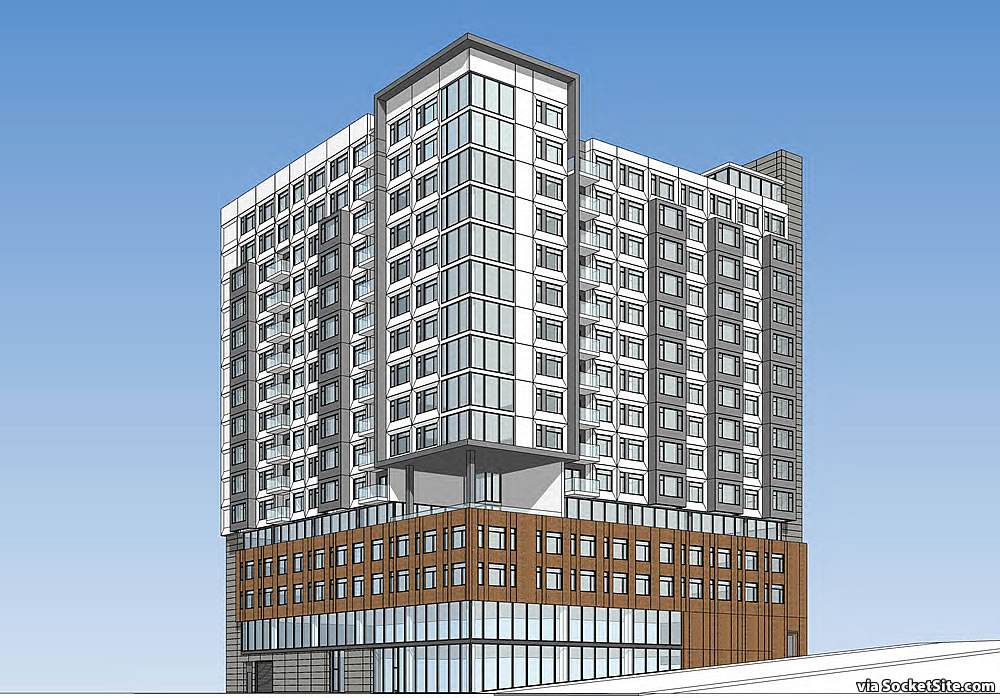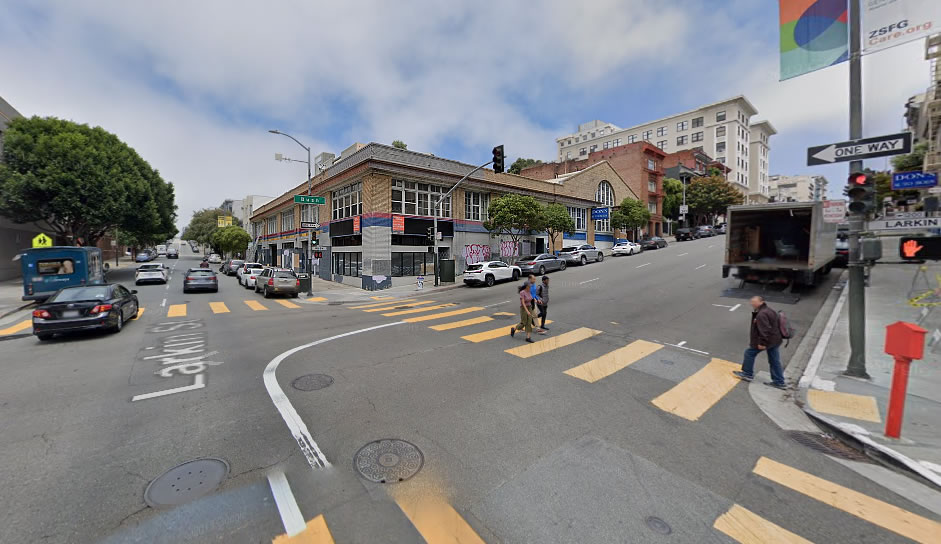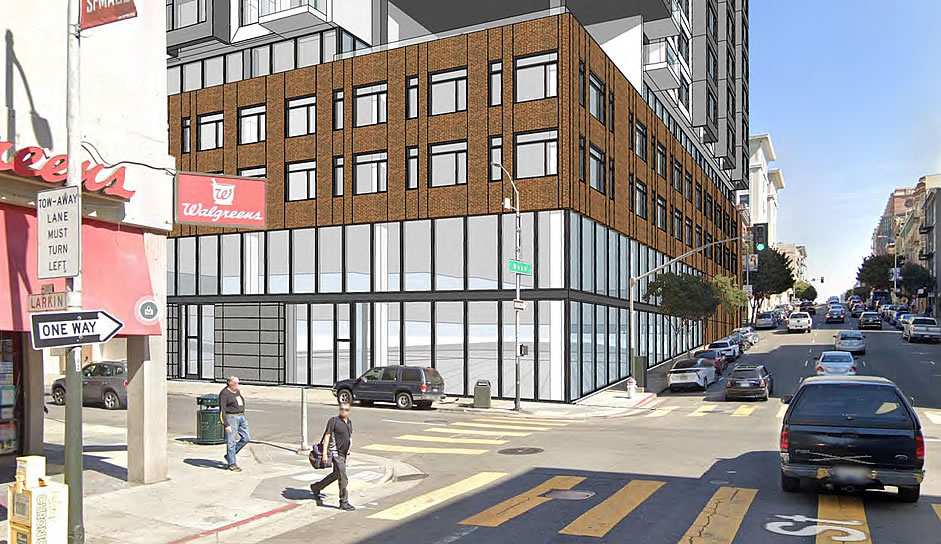Plans to demolish the two-story building and garage on the northeast corner of Larkin and Bush are in the works. And as envisioned, a 16-story building would rise up to 161 feet in height upon the site, which is twice as high as the limit for the site as currently zoned and for which a State Density Bonus is planned to be invoked.
The development as proposed would yield 198 units of senior housing, including both assisted and independent living units, with no off-street parking nor ground floor retail space at its base.
And yes, the existing building on the site, which was designed by Sylvain Schnaittacher and built in 1914 for the Taxicab Company of California, was identified as a historic resource, based on a number of different criteria, when surveyed for San Francisco’s Historic Auto Row.
We’ll keep you posted and plugged-in.



I don’t have a strong opinion on senior housing. How much of an advocate should I be?
Seniors need housing, so there’s a moral argument in favor. However, they are less likely to contribute to the workforce locally and probably spend less in the local economy, too. Finally, they do create jobs in the form of nurses / care folks.
What an odd question. What would you prefer: just housing for finance people?
Everyone should have high quality and affordable housing. Seniors are part of everyone.
I agree. Note that I led with the moral argument that seniors need housing.
Many people on this site complain about the fact that new construction is heavy on studios and 1 bedrooms, meant for young single people, and that we need more larger units for families. I agree with that sentiment. However, at least young, single people contribute to the workforce and spend heavily in the local economy. Families do, too. Seniors do not.
At first glance, senior housing doesn’t make as much sense to me in the middle of San Francisco, as it might in an outer neighborhood.
Fair.
This location is very walkable to doctors, hospitals and pedestrian retail. I think there is a concentration of senior housing in this area because of that, and I welcome it (along with jobs that is supports).
Stats on seniors not spending? I’d guess many active seniors actually spend more, given their free time for recreation and exploration.
And I’d think senior housing should be right in the middle of things, so seniors can easily get around in an urban environment, instead of having to be shuttled everywhere in vans or forced to ride Muni.
Here’s a stat referencing spend by age (chart halfway down the page). It declines significantly from 65-74 to 85+. So, as one might expect, the younger the better in terms of spend.
Senior don’t spend money? Not every senior is living a solitary existence in an efficiency drinking tea and watching Golden Girls reunions. It is 2021, many people are quite active now into their senior years and they go out and enjoy life, including eating out and enjoying themselves. Also, the link you provide summarizes a study that does not include anyone under 50, so I do not think you can draw any conclusions about how much “young people” spend, unless you consider someone 50 years old to be a young person. Also, the study is comparing a drop in spending from people 50 years old to those now in their elderly years, and I am not sure that pattern will hold up quite the same as more people live longer, healthier lives.
Finally, housing is built primarily to house people, not to eek out the highest financial return to the city, especially when we already have such an extremely wealthy city such as San Francisco.
The pros for urban senior housing I can think of are proximity to healthcare (esp if you have chronic disease requiring frequent appointments) and that seniors at that level (assisted) are not going to have cars so no need to think of supplying or impacting local parking while giving them a stimulating environment to walk around in and take public transportation. Having seniors in urban areas means that their family members who may live in that urban area can visit them too (vs driving out to middle of nowhere). But yes, if this was memory care level seniors, I might think it not a good idea (demented patient wandering into traffic?). As to contribution to local economy, I have no idea…I presume the more independent might have as much spending money as a recent, indebted college grad.
Great points about the type of senior / care. Agreed, its best for the mentally and physically fit.
A big pro for housing seniors in a dense city environment is community. Many people become increasingly isolated as they reach old age, having simple things like cafes and parks and churches within walking distance can make a huge difference in quality of life.
Due to demographic changes in American society, our nation has much greater demand for studio and one-bedroom homes than it used to. In 1960, just 13% of American households consisted of one person living alone. Today, 28% of American households have just one person.
Meanwhile, the share of households consisting of married couples with children has shrunk by more than half: in 1960, 44% of American households consisted of a married couple with children. By 2020, that share had fallen to 19% of households.
Meanwhile, on the supply side, exclusionary single-family zoning laws have reserved more than 80% of all residential land in the Bay Area for single-family homes only. Making so much land off-limits to smaller, more affordable housing types (e.g., cottage courts, rowhouses, duplexes, fourplexes, and apartment buildings) has resulted in a massive shortage of housing, and sent home prices and rents soaring.
The shortage has been especially extreme for the kind of housing we most need: smaller, more affordable homes that meet the needs of the Bay Area’s huge growth in one and two person households.
One of the best changes in state law in recent years has been the new laws that legalize building accessory dwelling units, with few restrictions. Many of the regulations that local governments used to use to block these homes (such as costly parking mandates) have now been removed by the state. Many seniors who live alone in single-family homes can now convert their garage or an extra bedroom into an accessory dwelling unit, rent it out to earn some more income, and simultaneously help someone who needs a modest home.
Hopefully, SB 9, which will legalize building duplexes in neighborhoods that currently have exclusionary single-family zoning, will also pass this year. If it does, it will help us catch up on building the smaller, more affordable housing types we really need.
As for this project in particular, I agree. We need more senior housing and this is a good place for it.
Well said.
I would note that past legislation effectively legalized duplexes on single family lots. You can build up to 1200 square feet in an ADU per State law. PLUS convert a portion of unneeded floor space within the primary residence to junior ADU. Of course, this is all rental housing. ADUs can’t be sold separately and Junior ADUs have to have a resident property owner on the site.
It’s good. You should be a big advocate.
Why?
As I understand it, there is a big backlog of properties where the owners are seniors and are having a hard time keeping up the size, yard, etc and using the stairs. However, they want to remain in the area. Having adequate senior housing in dense areas, especially near hospitals, the arts, etc, allows for seniors to move within their community and free up their homes for families. How many of these large SF houses and condos that could fit a family of 4-6 are occupied by 1-2 seniors?
Additionally, while they might not be as big in terms of spending in restaurants, they certainly support the ballet, opera, museums, etc more than younger residents.
This is a phenomenal point. Agreed. It might help reduce the terrible impact of Prop 13.
It doesn’t help at all, because the olds just put the house into J. Olde Boomer Perpetual Trust, keeping their 1978 assessments and renting the place out for $5000/month.
Thanks for sharing this. I hadn’t thought of it and found it a helpful framework for thinking about senior housing.
Well, here I am retired since Nov 2019 and thought I’d be spending my retirement along the canals of Venice sipping lattes, touring national parks all over the globe and shopping on Oxford St. No. Shut down for a year sheltering in place and then the husband diagnosed with cancer in Sept 2020. Not sure why not contributing to the workforce would even be an issue for housing since I’ve spent my enter adult lifetime (and many others have as well) up to the age of 70 contributing to the workforce and saving enough to be able to live somewhat comfortably in something like what’s proposed above. Unless you are never going to age (only in my mind have I stopped aging) I would recommend becoming an advocate of senior housing because the day may come when you need it.
SJ,
Sociopaths don’t care your past contributions, let alone your dignity as a human apart from your “contribution” to the “economy” (and whose economy might that be?); their only concern is what they can squeeze from you now. And they will frame it as though they were taking the moral highground.
I’m asking open-ended questions and hoping to get opinions. The commentary has swayed me in favor of the benefits of senior housing. No need to name-call.
name calling is the preferred technique of Maoists like two beers. Luckily we don’t a Red Guard Brigade he can captain to ensure reeducation of all (and they are MANY) people who are unworthy of his version of a 1969 Hippie Commune that he envisions San Francisco should be.
What, you think you’re never going to be a senior? How American of you.
I like old brick buildings too. But the frequency that unremarkable auto related structures in the van ness corridor are marked as historic are ridiculous.
Yeah you’d never know they just mark things randomly, rather than “identif(y) as a historic resource, based on a number of different criteria” like they should. Oh,wait…what ???
Anyway, it doesn’t seems to have ruined anyone’s plans: the renderings indicate it’s headed for Building Heaven.
seems a shame to not have ground-level retail, given that you will have hundreds of presumably mobility-challenged residents on the floors above you who might appreciate going to retail shops or restaurants within their own building.
I think it is fair to assume that without parking or externally facing retail, the first floor will be devoted to common area amenities to service the needs of the residence.
sounds good on paper but good luck finding a viable tenant in this location, and didn’t a major chain just close up right across the street.
This development project is very risky as the high end San Francisco senior housing market is already saturated including the soon to be completed Atria property on Van Ness and getting seniors out of their rent controlled apartments is challenging.
I’m not usually much of a fan of facade preservation, but with a building this large, it would work well. LARGE setback for roof-top garden at the roof of the existing garage, then a much taller tower for new units.
I’d love to see the Density Bonus Analysis. That is quite a bump they’re asking for.
They probably used the double-density provision in the Planning Code for senior housing, and then the State Density Bonus
I’m usually a bit sad when a building this large doesn’t include any ground floor retail, but I think it is worth it in this case given how much senior housing and assisted care units it would add.
Ground retail? the SF DA and policies around shoplifting have destroyed retail (in addition to online shopping). Even those primary online companies that basically use ground floor retail presence more as marketing tool (example Beta in Hayes valley) can’t survive or maintain retail shop with the unhinged amount of property crime.
If you want retail to come back, vote out the DA and the leftist sups.
No fan of Boudin here, but retail is dying all over America. The cause is Amazon, which is to say the cause is us.
Increased online shopping has long been a national trend, but in SF the rampant shoplifting does not help, and it pushes local residents to purchase more things online. Even large chains, such as Walgreens, which assumedly have the resources to absorb thefts as a cost of doing business have started shutting stores in the city and citing shoplifting as a contributing factor. And, even the stores in nice locations have become fortresses–everything is locked up, which makes shopping in person inconvenient and depressing. Certainly, the pandemic encouraged me to buy more things online, but even before, I found myself turning to Amazon (or other shopping sites) because going to the store had become so frustrating. I do not want to stand around waiting for a clerk to unlock a toothbrush, hand lotion, sunscreen, etc. Years ago, just a few items used to be locked up, but now one finds nearly the entire store’s inventory locked away. And, I see fewer of the brands on the shelves that used to be readily available. It is much easier to select exactly what I want on my phone and have it delivered directly to me. I enjoy going out and interacting with people, but I no longer enjoy shopping in a store.
I’m in no way defending Boudin. To me, he’s been terrible for the City.
My only point is that to blame the fall of retail on him isn’t fair. There were empty ground floor retail spaces all over San Francisco and all over America before he was elected. What’s happened to Walgreen’s is bad, though I’m more upset by his lack of prosecution of violent criminals.
in theory a pharmacy like walgreens or CVS would make a lot of sense below senior housing, but i agree that Boudin would just let the criminals prey on the elderly
All in favor of senior housing….any high-density housing actually…..but THIS is a HIDEOUS design. At least the residents won’t have to see it when they’re inside their units.
Agreed, terrible design. It will look dated before it is even finished.
Looks fine to me. Nothing great, nothing particularly ugly, either.
I live near this intersection. Although a bit further north, CVs and Walgreens are still thriving (with guards on the premises), they’ve been shuttered in this part of Polk Gulch and the reason I’ve heard is too much shoplifting. If it were just Amazon, then why are stores doing okay further north? I hope these are highly mobile seniors, who can walk several blocks to find stores still open, while dodging the crazies on the street shouting at pigeons.
You see crazy people bashing seniors for no reason all the time now. Crazy people are all over that part of Polk Gulch.
I usually don’t complain about how a building looks, but dear lord, the rendering is horrible. I really hope the finished product looks better